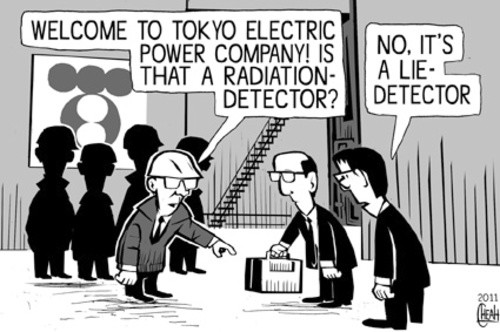From 2007:
"Not Again": Yet Another #TEPCO Scandal
Citizens' Nuclear Information Center
"Over the years there have been all sorts of cases of data fabrication and falsification at #nuclear, thermal and hydroelectric power plants. Each time the power companies and plant makers apologize and say that they will lance the wound, but then they go and repeat the same behavior over and over again. When Tokyo Electric Power Company (TEPCO) reported yet another case of data falsification to the Ministry of Economy Trade and Industry (#METI) the headline in the Fukushima local newspaper the following day (1 February 2007) was 'Not Again!', sigh the local people and the Prefectural government '.
"The latest scandal began when Asahi Shimbun newspaper reported on 31 October 2006 that #Chugoku Electric Power Company had falsified data for #DoyoDam on the #MatanoRiver. People might assume that the reason for #ChugokuElectric's admission was simply that it had made a judgment that the problem could no longer be concealed once it was leaked to the newspaper. However, there was more behind the admission than meets the eye. Even before this, anti-dam activists had been pursuing TEPCO over suspicious data related to its dams. For example, it had recorded flow measurements that could not possibly have been taken, because the locations were inaccessible due to heavy snow falls. Chugoku Electric's admission should be seen against this background.
"METI and the Ministry of Land Infrastructure and Transport responded by demanding that all electric power companies check their records. The upshot was that it was discovered that Chugoku Electric was not alone. In fact, it became apparent that all power companies had falsified and fabricated data in relation to such things as subsidence of dam embankments, and alterations to facilities without prior approval.
"The next major development came on November 15th, when it was revealed that Chugoku Electric had falsified data in relation to releases of hot wastewater at its #Shimonoseki thermal power plant. This led to similar revelations for nuclear power plants owned by TEPCO, #Kansai Electric Power Company (#KEPCO), Tohoku Electric Power Company and Japan Atomic Power Company (#JAPCO). On 10 January 2007 TEPCO submitted a report to METI entitled 'Causes of and measures to prevent a repetition of falsification of sea temperature data at the condenser outlets of #KashiwazakiKariwa Nuclear Power Plant, Reactors 1 and 4'.
"The report said, 'An investigation of power plants was instigated, because the Shimonoseki thermal power plant case reminded a worker that corrections had been made to sea temperature data.' As a result, falsification (referred to by TEPCO as "corrections") was discovered at Kashiwazaki-Kariwa reactors 1 & 4 and #Fukushima I reactors 1, 4 & 5.
"The hot wastewater referred to here is seawater, which has been used to cool and condense the steam used to drive the turbines of thermal and nuclear power plants. When the steam from the turbine condenses, its heat is transferred to the coolant, which in this case is seawater. The temperature of the seawater is raised in the process. If the seawater released is too hot, it can affect the ecosystem. Therefore, the temperature at both the intake and outlet points is measured and monitored to ensure that the temperature difference is not too great. At some power plants computers were programmed to record a higher than actual intake temperature, while at others they were programmed to record a lower outlet temperature. The readings were thus falsified to show a lower temperature difference than was really the case.
"On 31 January 2007 TEPCO released details of data falsification at its nuclear power plants. It admitted to a total of about 200 irregularities. A few examples are discussed below.
1. During a periodic inspection in May 1992 at Kashiwazaki-Kariwa reactor number 1 (K-K-1), the day before it was to be tested it was discovered that, due to a fault with the electric motor, the residual heat removal pump (part of the Emergency Core Cooling System (ECCS)) was not working. TEPCO staff made some adjustments to make it appear from the central control room that the pump was working. In this way, they were able to trick the METI inspector into awarding a pass for the inspection.
2. Again at K-K (the reactors are not specified), from around 1995 to 1997, measurements of the concentration of radioactive iodine released from the exhaust stack were made to appear lower than they really were by taking the measurements on the reverse side of the filter. In May 1995 the concentration of radioactivity from rare gases emitted from the exhaust stack of reactor 4 was also falsified.
3. From 1979 to 1998, in order to pass inspections, internal pressure readings for steam pipes connecting the reactor to the turbines at Fukushima I reactor 1 were falsified to match the specifications in the inspection guidelines. It was said that the specifications were inappropriate and that they were later amended so that falsification ceased to be necessary.
"There were many instances of malpractice besides these, in relation to periodic inspections and also in other areas. Fabrication and falsification had indeed become standard practice. Investigations are still proceeding and one cannot help feeling that the most serious and dangerous cases are still to come."
[And indeed it would come, 4 years later!]
http://www.cnic.jp/english/newsletter/nit117/nit117articles/nit117tepco.html
#CitizensNuclearInformatioNcenter #NoNukes #WaterIsLife #OceansAreLife #IAEAHides #TEPCOLies #FukushimaIsntOver #NoDumping #NuclearPowerPlants #RadioactiveWater #RethinkNotRestart #PacificOcean #DataFalsification
